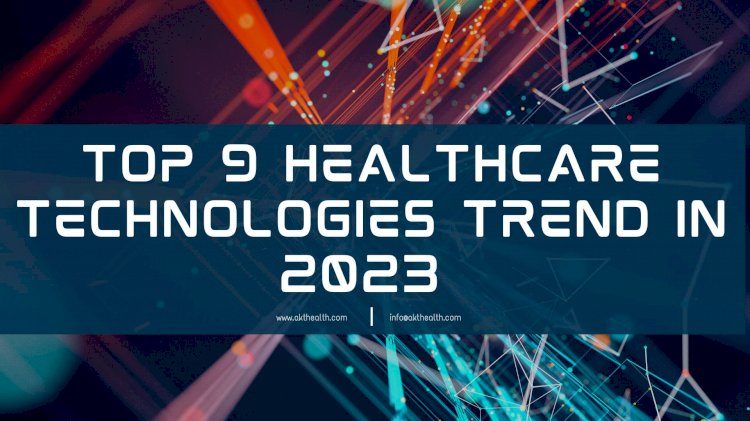Top 9 Healthcare Technologies Trend in 2023

The World has become a very different place than it was 10 years ago and this is more evident in healthcare. Healthcare is continuously evolving - from the widespread adoption of new technologies like metaverse, artificial intelligence, the Internet of Medical things, and more. 2023 is expected to strengthen the healthcare industry with breakthrough discoveries and innovations. Here we have anthologized the top 9 healthcare trends that could significantly impact the healthcare industry in 2023.
-
Artificial Intelligence in Healthcare: One of the fastest-growing trends in health information technology. Recent years have seen the rapid development of artificial intelligence (AI) technology, and the trend will continue in 2023. The Artificial Intelligence market size exceeded USD 5 billion in 2022 & is poised to depict over 29% CAGR through 2023-2032. This is a result of the rapid advancement in big data analytics in Healthcare. Some examples of areas where AI is used include drug discovery, where it can assist with predicting outcomes of clinical trials and potential side effects of new drugs as well as analysis of medical imagery, which involves using computer vision algorithms. AI also has applications in clerical work, such as processing insurance claims and management or analysis of medical record keeping. It can also be used to analyze data collected from patient wearable devices or in-home sensors used in virtual hospital settings to provide early warning or predictive diagnosis of various conditions. Putting together all of these use cases indicates that AI / ML will continue to be a prominent trend in healthcare throughout the coming year.
-
Monitoring Health through wearable Technology: IoMT is not a new thing in 2023, but this sector will grow exponentially in the coming years. The global internet of medical things market is projected to reach USD 187.60 billion by 2028 and exhibit a CAGR of 29.5% during the forecast period. Remote health monitoring and wellness apps are rising and will keep booming in 2023. This trend has fuelled the growth of a wide range of digital health products that let patients monitor their health, keep track of medication, manage symptoms, and alert doctors when something is wrong.
-
Integration of healthcare systems with Big data: Healthcare organizations have to deal with a vast volume of data. The amount of healthcare data accumulated and the number of data sources used by healthcare organizations will explode rapidly. The medical service provider will look for Modern platforms, including data fabrics, to combine and manage vast volumes of structured and distributed data. Cloud computing has played a crucial role in transforming healthcare by improving efficiency and reducing costs.
-
Universal adoption of Telehealth: It’s not surprising that the pandemic has definitely accelerated the adoption of telehealth solutions and virtual care to traditional healthcare and completely transformed the healthcare system. The market size of telehealth was valued at USD 83.5 billion globally and it’s expected to grow by 24% globally from 2023 to 2030 at a compound annual growth. Telehealth is a vital tool that has emerged as a new means of transmitting medical information. It involves using the internet, Videoconferencing, streaming services, and other communication technologies for the remote provision of healthcare services.
-
VR, Augment, and Mixed Reality in Healthcare: One of the latest trends in healthcare information technology. Computer-generated or augmented reality promises tremendous improvements to medical diagnosis and education. The AR and VR in the healthcare market size were valued at more than USD 2.5 billion in 2022 and are predicted to register over 21% CAGR during the forecast period of 2023-2032. The use of Augment Reality (AR) Virtual Reality (VR), and Extended Reality (XR)in medicine prepares nurses as well as Physicians and surgeons for real-life practice and procedures.
-
Data Breach Prevention- Despite all the tech precautions and healthcare provider awareness, data breach statistics demonstrate a dramatic increase over the past 10 years, with violations reaching their peak in 2021/2022. Hopefully, in 2023, healthcare providers pay more attention to their digital ecosystem and data protection. Owing to its convenience, facial recognition become one of the most popular technologies, ensuring authorized access of medical staff members to handheld devices or workstations. According to some reports, some companies have already delivered facial recognition of mask-wearing individuals with 99.9% accuracy.
-
Nanomedicine- Nanotech is slowly entering our daily life. By the end of 2021, the news spread around the globe: Scientists have created tiny organic robots(so-called xenobots) that are able to self-replicate. Nanomedicine is all about the use of nanoscale (Microscopically tiny) materials and objects, such as the diagnosis or treatment of living organisms. For example, it can be used as a potential hunter for cancer cells or viruses, which requires a group of nanorobots to be injected into a human’s blood vessels. This technology is expected to successfully fight back many genetic, oncologic, or auto-immune diseases on a cellular level, including tumors, arthritis, and others.
-
Interoperability and Data sharing among Healthcare entities: Interoperability involves creating a unified environment for health data which allows for information systems, devices, and applications to access, exchange, integrate, and cooperatively use data in a coordinated manner, within and across organizational, regional, and national boundaries, to provide timely and seamless portability of information and optimize the health of individuals and populations, globally. Data sharing and information exchange will help healthcare providers be able to reduce medical errors, better understand patients and improve patient care quality. As the healthcare industry moves towards holistic approaches and new technologies are developed, we believe that interoperability will be the driving force behind the future of healthcare systems.
-
Ensuring data privacy and security: As cloud computing and telehealth systems become more widespread, data privacy and security become a top priority for a healthcare organization to ensure that data from patients and personnel remain protected. To that end, blockchain technologies are widely discussed amongst many healthcare organizations as a potential method to ensure data protection. Data protection continues to be an evolving landscape.
As 2022, gives way to a new year and new opportunities, this is a good chance to review the health technology space and take strong steps toward the future. These are the top 9 healthcare technologies trend in 2023.

































